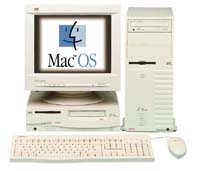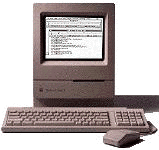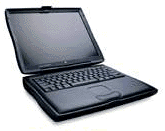My First Mac
Transformed by a Taste of Fruit
Keary "The Swingdevil" Ortiz - 2001.02.06
"Why do we need so much fruit?"
It was an honest question when the young boy pointed to the huge box his father brought home that day. The little boy was me, and the box in my father's hands was a Macintosh IIsi.
Thus, in an odd fashion, began my love of this unique fruit. It was 1990, and the dream machines of my time were the Lazer 128 Apple II clones in our first grade computer lab and the Amiga 700 at my best friend's house. I lived in a DOS-based world, a land of 320 horizontal pixels and 64 colors.
After the shock of the start up "ping" was over, I realized how amazing this little Mac was. With a screen scanning at a whopping 640 x 480 pixels, a full 256 colors, and an interface resembling a desktop, I was learning MacPaint and writing stories in Fullwrite Pro in no time. "The Gopher" was big, a text-based Internet that allowed me to tap into the databases of the great schools and institutions, download information at the speed of light with a 2400 bps modem. I was the resident computer genius in my second grade class, mastering the world, space, and time - and bending the images of gods to suit my whim (as much as Kid Pix would allow).
Jump to 1996. Suddenly the IIsi with it's lightning fast 20 MHz 030 processor were not quite so fast. Oddly my computer knowledge wasn't as amazing. The modem smoked with pain as AOL continued to crash, and after a relaxing dinner and movie, Photoshop 1 had still not loaded up.
It was time for a change.
"Why did you get a PC?!!?"
I cried the day I came home from school in 8th grade to find a boxy ATX tower sitting in my back bedroom. Upon pressing the power key, my worries turned quickly to confusion and awe. Gone was the baby ping of the IIsi, replaced by a grand orchestral boom that rumbled the northern hemisphere with the 8" Sony subwoofer below the desk. It was a Mac, but a Mac unlike any I had seen. This was no IIsi, no LC, no all-in-one Performa 520.
My father told me it was a clone, a SuperMac C600 made by the Umax
company under a license from Apple, based off the  motherboard of a Power Mac, with a PowerPC
603ev beating within. I had heard about Power Macs, but nothing had
prepared me for the power and speed. 3D design, a card made
specifically for graphics acceleration, a CD-ROM drive, a monitor
that could scan at more than one size, Internet, instant messaging,
a phone that was built right in. From the day the SuperMac came
home, I was never the same.
motherboard of a Power Mac, with a PowerPC
603ev beating within. I had heard about Power Macs, but nothing had
prepared me for the power and speed. 3D design, a card made
specifically for graphics acceleration, a CD-ROM drive, a monitor
that could scan at more than one size, Internet, instant messaging,
a phone that was built right in. From the day the SuperMac came
home, I was never the same.
Like a wonderful virus, the power of the Mac multiplied inside of me. Working as I never had before on a computer, I leapt ahead once again - learning more, seeing more, doing more. MP3s, VCDs, QuickTime, Marathon, Adobe Premiere, Flash, Unreal, Bryce, Avid Cinema, Ray Dream Designer. My knowledge grew and grew, only outweighed by my need for more. Yet as I passed through the garage to go to school every morning, I would stare sadly at the dirty beige heap that was our IIsi, feeling almost guilty for its pathetic state of decay.
I noticed the sad state of older Macs more every day. As much as I learned to love moving forward in the computer scene, I looked back, depressed by all the rotting, rusting, unused old Macs lying around in every house, school, and business I passed.
In the spring of 1999, my Mac collection began. I started with
the IIsi, cleaning it up and polishing it to its original shine.
 Next came a Classic, then a IIci and an LC. Friends, family, businesses,
schools - everyone wanted to give me their old Macs. "Get these
paperweights off my hands," they would laugh, throwing me an
SE or a Performa 630.
Next came a Classic, then a IIci and an LC. Friends, family, businesses,
schools - everyone wanted to give me their old Macs. "Get these
paperweights off my hands," they would laugh, throwing me an
SE or a Performa 630.
By May 1999, the collection had grown to 20 computers ranging from a Mac Plus to the flagship C600. By August, a Revision A 300 MHz iBook was added to the collection as my new main computer for high school.
By Halloween, I was tripping over the 34 Macs in my room, on my floor, in all the closets. Christmas past, my sister received an iMac DV, and my father came home with a new super-fast Lombard 400 G3 PowerBook.
By then the collection, starting with a 128k Mac and ending with the Lombard, contained 40 Macs. We had industrial shelves put into the garage to hold all these machines, and the collecting continued. My parents shook their heads, my sister's friends laughed, and my teachers berated me, all to no avail.
To make an extremely long story short, it's January 2001. Ten years have passed since the journey into a world begun on Superbowl Sunday in 1984 with one earth shaking commercial. (If you haven't seen Apple's first "1984" commercial, look it up, it's fantastic.)
The eight year old boy has grown greatly in size, little in
maturity. My house is clean, as the Macs have moved to various
locations across the city. I gave half away to public schools and
elementary students, while the rest are waiting for donation in the
storage room of my work. The iMac DV grows older in my sisters
bedroom, and I replaced the iBook long ago with a WallStreet 300 G3 PowerBook.
The iMac DV grows older in my sisters
bedroom, and I replaced the iBook long ago with a WallStreet 300 G3 PowerBook.
The SuperMac puffs on as my mother's school computer, still a great machine. The IIsi finally died due to a power spike, and a Blue & White Yosemite G3 tower (upgraded with a G4) sits in its place on my desk. Where the Classic once sat beside it is a dual-monitor Quadra 840av, and where Metallica posters once hung on my wall is the pearl white cloth banner sporting Titanium G4's profile.
At night you might hear the buzz of a case fan or two humming throughout the house, you might see the flashing of a cable modem, AirPort base station, or network hub connecting our machines. If perchance I left my closet light on, you could gaze at the polished black face of a NeXTstation, silently awaiting the day an OS will run on it again. Perhaps someone is downloading The Cure's "Wrong Number" from my Napster account, or a friend is futilely attempting to IM me as I sleep soundly, dreaming of what fruits the next morning my bring.